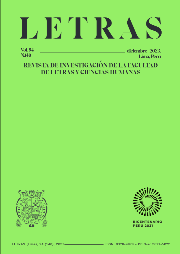How to name the unnamable one. Analysis of the body metaphor in Violeta Barrientos 'poetry
Abstract
In this paper, the writing about the invisible desire proposed by the collection of poems El innombrable cuerpo del deseo, published in 1992 by the Peruvian poet Violeta Barrientos Silva, will be studied. Through the metaphor of the body, the poetic voice confronts the heterosexual matrix, transforming the body into a space where the hegemonic desire can be disarticulated, by making possible a series of resistances that allows us to think of a homoerotic poetics. The collection of poems begins with the metaphor of the body linked to a desire, where the body is put before reason; then, it presents us with the impossibility of representing homoerotic desire within a heteronormative framework; subsequently, we evidence a struggle for the representation of a homoerotic voice, which will finally become evident in the very transgression of the gender configuration. To develop this proposal, we will rely on the concepts of rhetoric and gender studies, specifically, the metaphor (Stefano Arduini, and George Lakoff and Mark Johnson), the body and performativity (Judith Butler) and homoeroticism (Andrés Santana). Thus we will focus on the poems that allow us to answer questions about the body and the construction of a discourse of homoerotic resistance.Downloads
Métricas alternativas
References
Arduini, S. (2000). Prolegómenos a una teoría general de las figuras. Universidad de Murcia.
Barrientos, V. (2013 [1992]). El innombrable cuerpo del deseo. Intermezzo Tropical. Butler, J. (2002). Cuerpos que importan: sobre los límites materiales y discursivos del “sexo”. Paidós.
Deleuze, G. y Guattari, F. (1997). Mil mesetas. Capitalismo y Esquizofrenia. Pre-textos.
Glavic Maurer, K. (2010). La operación materna en Jacques Derrida: problemas y posibilidades para una deconstrucción de lo femenino [Tesis para optar al grado de Magíster en Filosofía con Mención en Axiología y Filosofía Política], Universidad de Chile. Facultad Filosofía y Humanidades. Repositorio institucional. https://repositorio.uchile.cl/handle/2250/108642
Lakoff, G. y Johnson, M. (1995). Metáforas de la vida cotidiana. Madrid: Cátedra.
Moreno Sainz, Y. (2017). Judith Butler y la construcción del sujeto en términos performativos. THÉMATA. Revista De Filosofía, (56). https://revistascientificas.us.es/index.php/themata/article/view/2956
Ollé, C. (1994, 21 de julio). Las poetas de los 80 seducidas por el mal. Todas las artes (Revista peruana de cultura total), 1(1), 11-16.
Quijano, A. (2000). Colonialidad del poder; eurocentrismo y América Latina. En Lander, E. (Comp.), La colonialidad del saber: eurocentrismo y ciencias sociales. Perspectivas latinoamericanas (pp. 342-386). Consejo Latinoamericano de Ciencias Sociales.
Quijano, A. (2006). Don Quijote y los molinos de viento en América Latina. Investigaciones Sociales, 10(16), 347–368. https://doi.org/10.15381/is.v10i16.7030
Reisz, S. (1998). “Escritura femenina” y estrategias de auto-representación en la “nueva” poesía peruana. En Kohut, K., Morales, J. y Rose, S. (Eds.), Literatura peruana hoy. Crisis y creación (pp. 218-233). Vervuert Verlag. https://doi.org/10.31819/9783954879809-019
Rojas-Trempe, L. (1999). Alumbramiento verbal en los 90. Escritoras peruanas: signos y pláticas. Arteidea.
Rojas-Trempe, L. (2002). Escritoras peruanas al alba del próximo milenio. En Castillo, D. y Satller, B. (Ed.), Perú en su cultura (pp. 175-181). Ediciones Lepas.
Vich, V. (1992). El innombrable cuerpo del deseo. Imaginario del arte (Revista de Literatura y otras Imágenes), 4, 21.
Copyright (c) 2023 Letras (Lima)

This work is licensed under a Creative Commons Attribution 4.0 International License.
Este obra está bajo una licencia de Creative Commons Reconocimiento 4.0 Internacional



















